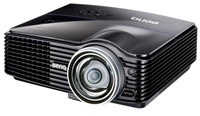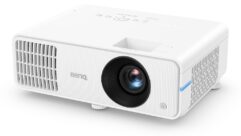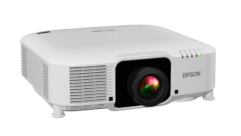

Technology Showcase: Home Theater Projectors
Aug 5, 2009 11:58 AM,
By Jay Ankeney
The latest illumination options create more versatile home theaters.
If you want to get the big picture, nothing beats a projector. Home theater projection systems are proving to be one of the most innovative market segments of the domestic entertainment business. Prices are coming down, new market segments are being developed, creative technologies are being introduced, and the options being offered cover the spectrum from relatively inexpensive models for those who want a big picture at a small price to the videophile who demands a home experience that rivals that of the local Cineplex—and in some cases exceeds it.
There is a major irony in this trend. Back in 1953, when 20th Century Fox released the first CinemaScope feature, The Robe, the studio also coined the term “letterbox” to describe the dimensions of the new, wider theater screen. The goal was to enable movie theaters to lure audiences out of their living rooms by offering a bigger picture than early TV sets could provide.
Now, many home theater setups can provide images that distend the viewer’s field of vision as fully as their neighborhood movie palace screens, without the sticky floors and overpriced popcorn. More recently, Hollywood has helped theater owners fight back with 3D attractions. But since these are based on digital cinema presentations, that technology is rapidly migrating into home theater projectors to the extent that, once 3D content for the home becomes more readily available, the stay-at-homes may once again have an option that will make them question the rising price of theater tickets.
Of course, ever since Kerns H. Powers proposed the 16:9 (1.78:1) aspect ratio in 1984 as a video compromise for all the different conventional and widescreen cinema formats, people increasingly have grown to expect watching rectangular images on digital home screens, and for many, 16:9 fits the bill. Videophile purists, however, want to get as close to the real movie theater widescreen experience as possible. So ignoring the fact that CinemaScope was originally 2.35:1 and that modern anamorphic productions are actually shot in 2.39:1, the companies producing DVDs often just round this up to 2.40:1. Projector manufacturers, however, usually reference the more accurate 2.35:1 ratio.
The imaging chips inside most projectors are still designed to present native 16:9 pictures from a 1920×1080 pixel array. If you can handle the compromise, adding black bars at the top and bottom of the screen will let your projector present most of the content contained in a widescreen display on your home screen. Those black bars represent unused pixels, reducing the 1920×1080 image frame to an effective 1920×817 picture elements. To see all those pixels you are paying for, the projector needs to be able to put out its images in vertical stretch mode—also called Mode One. Then you need to add an anamorphic lens to the front of your projector, and the good folks at Panamorph will be glad to provide you with one. Actually, almost 90 percent of the stretch-out lenses seen in America are from Panamorph or one of its OEMs. Internationally, the market is well-shared by Schneider Optics.
The energy needed to run those projectors has become an issue, however, as everyone wants to go green. One of the most hopeful responses to this has been the introduction of LEDs as light sources to replace the more common high-pressure mercury lamps (UHP or mercury vapor lamps) used by most projectors. Measured to the point when they put out half their rated illumination, most of these lamps last 2000 hours in full power usage or 3000 or more hours in what has become to be known as “eco mode.” It’s even less for the more expensive xenon lamps.
Now—especially at the recent InfoComm—we are starting to see LED lighting technology coming onto the market, with red, green, and blue LEDs eliminating the need for color wheels to achieve a wider and more consistent color gamut. What’s great about LEDs is they promise up to a 50,000-hour life free of maintenance and relatively low power consumption. Just for comparison, the implementation of LED illumination would let you run a home theater projector up to 24 hours a day, seven days a week for more than four years without changing a lamp.
The downside is that due to their heat output and the need for sophisticated drive circuits, among other considerations, LED projectors are limited to sub-1000 lumens in output so far. However, it is said that because of a phenomenon called the Helmholtz-Kohlrausch (H-K) effect, the increased color saturation of the RGB LEDs is perceived by the viewer as part of the image’s brightness. This is better known as chromatic luminance since achromatic luminance (also known as “white”) is the usual standard of comparison. As a result of the H-K effect, LED projectors appear to be about 25 percent brighter than a similar UHP lamp home theater projector rated at the same lumens.
Home projectors have been traditionally provided a satisfactory 1000-ANSI-lumen to 1500-ANSI-lumen output since they were intended for almost completely darkened home theaters. However, another evolution on the illumination front is improved light-source efficiencies that seem to be encouraging the development of a new market segment often called “living room projectors.” Their brightness of 2000 lumens or more permit these projectors to be enjoyed in parts of the house bathed in ambient light.
When it comes to resolution, 1080p and WUXGA resolutions are all the rage. This means many projectors using 720p output are now on the market at significantly reduced cost. Whether the average viewer can tell the difference on smaller screens is left to the eye of the beholder. In addition, the advent of short-throw designs—long popular in educational settings—eliminates the irksome problem of having people walk in front of the projector’s throw when it is mounted in the back of the room. Positioned only inches from the screen and easy to move from room to room, short-throw projectors may prove to be very accommodating in future home theater installations.
Technology Showcase: Home Theater Projectors
Aug 5, 2009 11:58 AM,
By Jay Ankeney
The latest illumination options create more versatile home theaters.
BenQ MP776 ST
Here is a look at some of the most interesting new home theater projectors that are coming onto the market.
Targeting the high end of home cinema, BenQ’s W30000 combines full HD 1080p cinema performance with the advantages of progressive LED technology that is able to provide a 128 percent NTSC color gamut (compared to the average 55 percent to 80 percent NTSC of most projectors) complemented by an extreme 100,000:1 contrast ratio. Coupled with BenQ’s filter-free DLP design for flawless, never-fade color accuracy, the LEDs in the W30000 provide 20,000 hours of projection lighting supported by Texas Instruments’ (TI) BrilliantColor and DynamicBlack, 600 ANSI lumens, and Hollywood Quality Video (HQV).
For an ultrashort-throw design, BenQ’s new MP776 ST with Crestron RoomView is replacing last year’s MP771, providing a 0.6 throw ratio that projects an 81in. big-screen view from just 3.3ft. away. In addition, BenQ’s new W6000 Ultra-Bright DLP projector employs high-end technologies including Philips’ Vidi, TI’s DynamicBlack and BrilliantColor, Imaging Science Foundation calibration standards (ISFccc), exclusive 3D color management, and an exceptional 50,000:1 high contrast ratio at 2500 ANSI lumens, which means it can be installed in a living-room environment. The W6000 boasts full HD resolution and dual HDMI 1.3 ports for pure digital connection to HD equipment.

Digital Projection International M-Vision 1080p-260
Originally formed in 1987 as a division of the Rank Organisation and having introduced the world’s first 3-chip DLP projector in 1997, Digital Projection International announced its M-Vision 1080p-260 at InfoComm 09. The unit produces 3500 lumens and greater than 2000:1 contrast from a single DLP chip, and its compact and lightweight chassis design includes a lens-shift range of 30 percent horizontal and 120 percent vertical. Multiple lens options provide further flexibility, with a throw range from 1.25 to 3.0:1. The M-Vision 1080p-260’s full HD resolution, integrated electronics, and straightforward user interface make this projector a viable solution for installations where affordable simplicity and imaging quality are paramount.
The Epson PowerLite Pro Cinema 7100 3LCD 1080p projector has Imaging Science Foundation calibration capability to customize its settings, Epson’s new D7 panel, and a contrast ratio up to 18,000:1 at 1800 lumens brightness. The Pro Cinema 7100 increases its energy efficiency with a new long-life E-TORL (Epson twin optimized reflection lamp). Epson’s PowerLite Pro Cinema 7500UB (“UB” for UltraBlack technology) projector raises the contrast ratio to 75,000:1 through its built-in Silicon Optix HQV processor.
In addition, the Ensemble HD all-in-one home cinema system from Epson is a fully integrated, high-end 3LCD solution complete with a motorized 100in. screen, integrated surround sound, AV controller with built-in DVD player, universal remote, and all components needed for installation. Epson’s Ensemble HD is available in three models: the Ensemble HD Home Cinema 720p, the Ensemble HD Home Cinema 6100, and the Ensemble HD Home Cinema 6500 UB.

InFocus ScreenPlay 8602
Being launched just this month, the InFocus ScreenPlay 8602 puts out 1920×1080 images in 1080p with 10-bit processing at 1300 lumens with a 30,000:1 iris-assisted contrast ratio from the company’s own Unishape lamp technology. InFocus claims its 1.5:1 zoom, throw ratio, lens shift, and rich connectivity coupled with cable management and customizable skins make its ScreenPlay 8602 the ideal upgrade from 480p, 720p, or older-generation 1080p projectors. One reason is that the ScreenPlay 8602 has ISF calibration settings and 2.35:1 support via onboard triggers. Its replaceable case skins and lack of exposed cables let the homeowner match the look of the ScreenPlay 8602 to any living-room or home theater décor. InFocus even equips its ScreenPlay 8602 with a glow-ring feature that clearly indicates the projector’s operating state.
Technology Showcase: Home Theater Projectors
Aug 5, 2009 11:58 AM,
By Jay Ankeney
The latest illumination options create more versatile home theaters.

JVC DLA-RS10
At the heart of JVC’s DLA-RS10 home theater projector are three 0.7in. 1080p D-ILA devices (JVC’s version of LCoS), a new optical system that uses wire-grid polarizers, and a native contrast ratio of up to 32,000:1. The DLA-RS10 comes with a 2X lens that has a three-step fixed aperture. It boasts an advanced HQV Reon-VX processor by Integrated Device Technology (formerly Silicon Optix) and a 2X motorized zoom lens with an auto dust cover to give you 1000 lumens brightness.
In addition, bringing THX-certified performance to your home theater, JVC’s DLA-RS20 projector includes a new high-precision 17-element motorized lens with an upgraded optical path. Its three-panel D-ILA light engine produces 900 lumens brightness with a 16-step fixed aperture.
Finally, JVC also offers its 4K projector, the DLA-RS4000, for home theater. For maximum performance, the DLA-RS4000 has a patented five-element, 100-percent-glass, fully multicoated optical design corrected for chromatic aberration and astigmatism in standard home cinema environments.
It’s the unique calibration capabilities of Kevin Knoll built in to every unit that makes the home theater projectors from Knoll Systems special. The company’s HDP-1100 short-throw model features the DLP 16:9 MaxPlay DMD chip (1920×1080); Nikon lenses; manual 140 percent up, 60 percent down, and 15 percent horizontal lens shift; and ± 15 percent horizontal and ±30 percent vertical digital keystone correction. With an 850-ANSI-lumen light output at a 3600:1 contrast ratio, Knoll’s HDP-1100 short-throw projector has a 1.34-1.65 short-throw distance (1.25X zoom), and it comes with a lamp rated at 2000 hours (3000 hours in whisper mode) and a 33dBA noise level.

Knoll Sysems’ HDP-1200
Knoll Systems’ HDP-1200 long-throw projector outputs 950 ANSI lumens at a 4400:1 contrast ratio, the same kind of lens shift and digital keystone correction as that of the HDP-1100, and the same Knoll calibration and processing for the best performance after installation. Like its short-throw brother, the HDP-1200 can put out a true 2.35:1 image with the addition of an anamorphic lens.
Putting out a whopping 10 megapixel (4096×2400) ultrahigh-definition display from three 1.27in. diagonal 4096×2400 D-ILA chips, the Meridian810 Reference Video System delivers beyond-cinema-quality images, exceeding the resolution of some commercial digital cinema projectors. Using a brand-new light engine with a PKI xenon lamp, its up-to-4000-lumen output delivers SMPTE cinema reference level for reflected light (16ft.-L) from gray or white screens and a 10,000:1 contrast ratio thanks to its organic polarization grid. The 810 Reference Video Systems are fine-tuned at Meridian’s facilities over four days using exclusive calibration technology developed by William Phelps. The system boasts interchangeable lenses in short-, medium-, and long-throw packages including a motorized 2.35:1 anamorphic lens. A very-short-throw package is also available.

Mitsubishi HC7000
Mitsubishi’s new 1080p HC7000 and HC6500 3LCD premium projectors are available exclusively through custom home theater system integration and high-end retail channels as part of Mitsubishi’s Diamond Series line. The HC7000 HD projector boasts 1000 ANSI lumens at a 72,000:1 contrast ratio, and the HC6500 outputs 1200 ANSI lumens at a 15,000:1 contrast ratio. Both provide anamorphic lens Modes 1 and 2 support, giving you either 2.35:1 or 16:9 aspect ratios, and both incorporate the HQV high-performance video processor, the Reon-VX video processing chip. They also come with two HDMI version 1.3 inputs to provide easy setup options for multiple video inputs. With a lamp life estimated at up to 5000 hours in low mode, Mitsubishi’s HC7000 and HC6500 let you change the lamps through an easily accessible lamp housing without disassembling the mounting structure.
Just this month, Optoma is bringing out the first 1080p DLP projector for less than $1,000, the HD20, which comes with two HDMI inputs and provides 1700-ANSI-lumen brightness at a 4000:1 contrast ratio. Optoma’s HD20 is going to expand the audience for sharing big-screen movies and sporting events or for taking your videogaming to the next level by connecting this 1080p projector to your favorite game console.
At the high end, Optoma’s HD8600 is built around a single 0.65in. 1080p DMD DLP chip, and it features interchangeable lenses and an enhanced PureMotion engine with the latest ME/MC processing from Pixelworks. The HD8600 offers extended Pureshift (full vertical [0 percent to 120 percent] and horizontal shift [±10 percent]), has three lens options for the most flexible installation placement, and is 2.35:1-compatible when equipped with optional anamorphic lens kit BX-AL133B.
Technology Showcase: Home Theater Projectors
Aug 5, 2009 11:58 AM,
By Jay Ankeney
The latest illumination options create more versatile home theaters.

Panasonic PT-AE3000
A newly designed optical system that achieves a 60,000:1 contrast ratio and 1600 lumens of brightness is the highlight of Panasonic’s PT-AE3000 full HD LCD home theater projector. With double-speed drive capability, the performance of the AE3000 is further boosted by Panasonic’s collaboration with leading Hollywood filmmakers. That has resulted in advanced signal-processing technologies, beginning with Detail Clarity Processor 2 and Frame Creation Interpolation, which renders a smoother, sharper image when the camera is panning. For those comfortable with 1280×720 resolution, Panasonic’s PT-AX200U can satisfy either sports or game fans with its 2000-lumen brightness and a game mode that reveals detail lost in dark areas and improves signal processing for better response for game action.
Specializing in the performance end of the home theater projector marketplace, projectiondesign’s avielo series projectors are hand-built in Fredrikstad, Norway. One of the series, the kroma, is an LED-based 1080p home cinema DLP projector shining 650 ANSI lumens with a contrast level of up to 7500:1 (adjusted) and a life expectancy of 50,000 hours. Using projectiondesign’s ReaLED technology, the kroma model benefits from projectiondesign’s implementation of high-power LED lights with one each for the red, green, and blue colors, and a prismless optical path that ensures no flare in the light path.
At InfoComm 09, projectiondesign had four different 3D projection systems including the F10 AS3D active stereo projector and the F32 1080 displaying passive stereo using built-in interference filter technology (Infitec). The company also showed off a ColorCode 3-D projection system. As opposed to most stereoscopic 3D systems, ColorCode 3-D requires only a single image on the screen—in this case, from a projectiondesign F80 3-chip DLP model—but it can still present a very convincing depth of image for a modest capital outlay.
Runco International has put all its engineering knowledge into its new Reflection series RS-900 DLP projector, which incorporates the company’s powerful SuperOnyx technology for pristine high-definition images at today’s highest available resolution. It also features an illumination system featuring Runco’s exclusive Selectable Lamp Intensity Control (SLIC), which provides two user-determined lamp intensity levels to allow maximum flexibility for screen size, ambient light conditions, brightness, and contrast balance, and to maximize the usable lamp life. The RS-900 has been engineered to comply with ISF standards for proper setup and calibration, ensuring maximum home theater image quality.
On the highest end, Runco’s Signature Cinema SC-1 with 2K resolution uses the company’s exclusive Signature CineStep Process to produce exceptionally deep black levels, dynamic contrast, and detail, and eliminate undesirable RGB characteristics associated with digital projection. The SC-1 incorporates Runco’s most advanced widescreen DLP technology, with three SuperOnyx DMDs boasting a phenomenal native resolution of 2048×1080.
From the Planar (Planar is actually Runco’s parent company) line, the 3-chip DLP-based Viper home theater projector offers a 10,000:1 contrast ratio and 2000-ANSI-lumen output calibrated at D65. It’s also designed for screen sizes greater than 110in. The Viper features include five lens options, power zoom and focus, horizontal and vertical lens shift, DynamicBlack video, and HD 3-chip technology. It also boasts a customized Gennum GF9450 with 10-bit independent dual-channel image processing, true 1080i deinterlacing, MPEG artifact reduction (block and mosquito noise), the latest motion-adaptive processing, and 3D noise reduction.
Technology Showcase: Home Theater Projectors
Aug 5, 2009 11:58 AM,
By Jay Ankeney
The latest illumination options create more versatile home theaters.

Samsung SP-A800B
The new Joe Kane Signature series was launched this Spring by Samsung with the help of Joe Kane, one of this country’s leading HD experts. The series includes two digital DLP projectors: the SP-A800B and SP-A900B. Both are 1080p single-chip DLP projectors with an image brightness of 1000 ANSI lumens; a resolution of 1920×1080; one of the finest lenses found on any projector; internal signal scaling; a 24-frame mode; and the capability of nearly perfectly reproducing all three of the world’s broadcast color standards including HD, SMPTE-C, and EBU. Samsung’s flagship SP-A900B has a 35 percent increase in contrast ratio over the SP-A800B, and it delivers a premium home theater experience with 1000 ANSI lumens and a true 24-frame film mode that recreates each still frame for cinematic high-definition picture quality. Samsung’s SP-A800B is not only capable of reproducing broadcast-standard colorimetry, but it can also be calibrated to HD, SMPTE-C, and EBU standards, coming to within an astounding ±.001 in both X and Y coordinates for red, green, and blue.
Offering a dual-lamp system that allows for increased light output and a user-changeable twin color-wheel system that increases color reproduction and light-output efficiency, the PDG-DHT100L from Sanyo Presentation Technologies is compatible with Sanyo’s exclusive uncompressed HD data wireless transmission system, which is available as an option. The PDG-DHT100L is outfitted with two 330W UHP lamps and a twin color-wheel system, and it puts out a full HD (1920×1080) signal at 6500 lumens. Sanyo’s Real Color Manager makes it easy to adjust the white balance and gamma curve by simply comparing the projected images from the CD-ROM included with the PDG-DHT100L against the images on the enclosed photo sheet.

Sharp XV-Z15000
The latest from Sharp, the XV-Z15000, is a 1080p DLP home theater front projector that bundles an impressive 30,000:1 dynamic contrast ratio and 1600-ANSI-lumen brightness into a price-competitive model that can still reproduce a theater-like cinematic experience. The XV-Z15000 presents a 16:9 widescreen movie aspect ratio, a full HD native resolution of 1920×1080, and a 24Hz film mode that lets it delivers an accurate representation of the film’s originally intended frame rate, giving consumers a more realistic viewing experience. A powered iris switchover function on the XV-Z15000 gives the consumer enhanced control over brightness and contrast settings with the touch of a button on the remote control.

SIM2 Grand Cinema C3X
SIM2’s Grand Cinema C3X 1080 3-chip DLP projector has a stylish, compact form thanks to SIM2’s proprietary Alphapath light engine. With 10-bit video processing (1080p at 24Hz compatible), the Grand Cinema C3X 1080 benefits from the latest 0.95in. 1080p DarkChip4 DLP chipset from Texas Instruments. That helps it attain a contrast ratio greater than 10,000:1. For ease of installation, three lens options are available: T1 (short-throw), T2 (standard long-throw), and T3 (long-throw), allowing for flexibility in the positioning of the projector.
The latest addition to SIM2’s Grand Cinema C3X series is the modularly designed Grand Cinema C3X Lumis HOST (High-definition Optical Signal Transfer), which divides the projection system into its two major constituent parts: the projector itself and the processing electronics. With a brightness output adjustable from 1200 ANSI lumens to 3000 ANSI lumens and a contrast ratio up to 35:000:1 with DynamicBlack technology, the Grand Cinema C3X Lumis HOST connects its two modules with a three-line digital, high-integrity fiber-optic connection up to 250 meters. The SIM2 HOST module houses the projector’s control electronics in a discrete unit designed for maximum flexibility of placement. The HOST incorporates flexible video switching with six HDCP-compliant HDMI inputs; three HD-capable component-video inputs; an array of legacy composite and S-Video inputs; and RGB, DVI, and SDI professional inputs. A dedicated 10/100Mbps Ethernet connector (LAN) is fitted as standard on the SIM2 HOST, allowing the product to be connected to a LAN network or to the Internet.

Sony VPL-HW10
The flagship of Sony’s home theater lineup is the VPL-VW200 because it offers full HD 1080p, Motionflow 120Hz with black-frame insertion, 35,000:1 contrast ratio (with Advanced Iris) from a high-output xenon cinematic lamp, x.v.Color capability, and a 12-bit panel drive full digital chassis. The VPL-VW200 combines the advanced features of Sony’s QUALIA 004 and the sleek form factor made popular by its VPL-VW100 projector. The panel-alignment function on the VPL-VW200 allows the precise convergence of RGB images with zone-specific adjustment to deliver a sharper, crisper picture. An exclusive Carl Zeiss multi-element glass lens optimizes the VPL-VW200’s SXRD (Silicon X-tal Reflective Display) chip performance. SXRD is Sony’s proprietary version of LCoS.
For those on more of a budget, Sony also offers its VPL-HW10 with 1080p, three SXRD 1920×1080 panels, up to 30,000:1 contrast ratio, 1000-ANSI-lumen brightness, and a 200W ultrahigh-pressure lamp. This entry-level projector includes Sony’s Bravia Engine 2 digital video processor and an ARC-F (All Range Crisp Focus) lens. It also comes with the company’s Image Director 3.0 software application, available on CD-ROM with the VPL-VW200, to help you fine-tune image quality by adjusting the projector’s gamma curve with the help of a PC.

ViewSonic PJD6381
Just available this month, the PJD6381 from ViewSonic has one of the shortest throw ratios available for a DLP projector on the market, with a ratio of .68 (the throw distance from the projector divided by the width of the screen), 1024×768 XGA resolution, 2500 ANSI lumens, and a 2500:1 contrast ratio. With the PJD6381, you can enjoy 3D home entertainment thanks to its 120Hz refresh rate as the projector is compatible with the two leading stereoscopic 3D technologies: Texas Instruments DLP Link and Nvidia 3D Vision.
In addition, ViewSonic’s cost-efficient Pro8100 offers full 1080p HD resolution, a C2Fine liquid crystal panel, and a Reon-VX high-performance video processor with HQV. With 1000 ANSI lumens, a 13,000:1 contrast ratio, and 2.35:1 anamorphic viewing option on the Pro8100, ViewSonic’s Precision Color System provides sophisticated color tuning including 33 levels of gamma correction, 3D color management, and auto contrast.

Vivitek H9080FD
The Vivitek H9080FD home cinema projector, just released in July, is one of the first of the new wave of LED-based, 1080p projectors that outputs a 100,000:1 contrast ratio at a brightness of 800 lumens. Benefiting from advanced image-processing technologies from Gennum, the H9080FD’s lamp-free, Luminus PhlatLight RGB LED light source is estimated to provide up to 20,000 hours of operation in normal viewing conditions. The Vivitek H9080FD is mercury-free, with a dust- and filter-free, sealed engine design that eliminates constant filter disposal and cleaning.
In June, Vivitek also launched two short-throw projectors for the home, the D925TX and D930TX, which can cast a 100in. (diagonal) picture from a distance of about 4ft. Vivitek’s D930TX features a brightness of 3000 lumens, and the D925TX has 2500 lumens of brightness. Both projectors have a contrast ratio of 2400:1, offer native XGA (1024×768) resolution, and feature multiple connectivity options including HDMI and RJ-45.










